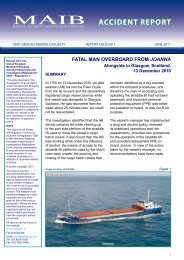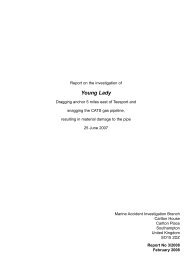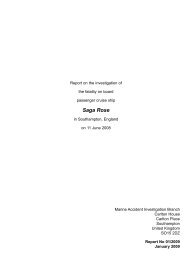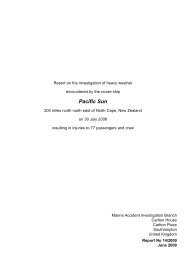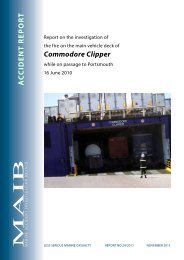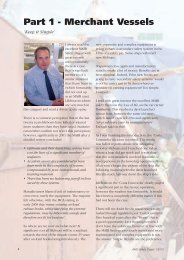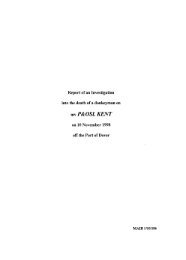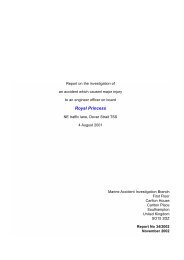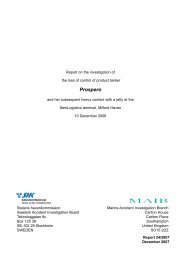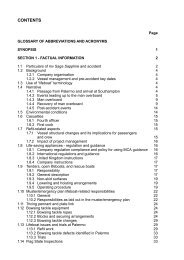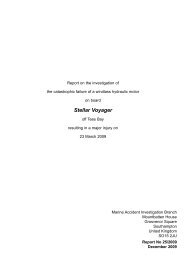Sichem Melbourne - Marine Accident Investigation Branch
Sichem Melbourne - Marine Accident Investigation Branch
Sichem Melbourne - Marine Accident Investigation Branch
Create successful ePaper yourself
Turn your PDF publications into a flip-book with our unique Google optimized e-Paper software.
2.4<br />
2.5<br />
20<br />
MASTER / PILOT ExChANGE OF INFORMATION<br />
The pilot arrived at the ship approximately 20 minutes before departure, with a preprepared<br />
passage plan (Annex 5) of his own style and construction, rather than the<br />
PLA house style plan. The plan showed the vessel’s expected passage from mid<br />
channel but did not describe the berth departure manoeuvres on leaving the jetty.<br />
An exchange of information took place between the master and pilot, with much of the<br />
conversation recorded by the VDR. This exchange included: a review of the vessel’s<br />
pilot card; a brief discussion on the similarities with the sister ship, <strong>Sichem</strong> Edinburgh,<br />
and where they would anchor. The VDR also recorded the pilot explaining to the<br />
master that it was still ebb tide and that the stern lines should be let go first, followed<br />
later by the forward springs. He did not, however, explain his intention to come off the<br />
jetty astern into the main channel. The pilot felt this needed no further explanation,<br />
concerned that the master may take any further explanation of something so basic as<br />
an insult to his professional competence.<br />
The master’s passage plan (Annex 1) showed that after unmooring they would pick up<br />
the channel on a course of 139º; this was also entered on his chart plan. He expected<br />
to leave the berth, going ahead with continuous port helm and thrusting the bow to<br />
starboard, thus carrying the vessel transversely away from the jetty. However, this<br />
intention was not adequately shared with the pilot during the exchange of information.<br />
It was the master’s opinion that if the tidal stream was sufficiently strong to need to go<br />
off the berth astern then a tug would be employed.<br />
PLA provided pilots with a house style multi purpose document to assist them with<br />
passage planning and the exchange of information (Annex 4). The three page<br />
document incorporated: billing information; a page for the passage plan and information<br />
exchange (incorporating a section specifically for sketching manoeuvring/mooring); and<br />
a page showing the outer reaches and various channels in the estuary, again to allow<br />
pilots to sketch proposed routes. PLA did not insist on the use of this document, other<br />
than the billing information, which was mandatory. They reluctantly agreed to pilots<br />
using their own style plans, provided they retained them for a period of 3 months after<br />
each act in case they were required for auditing purposes or incident investigation; PLA<br />
had previously issued a memo to its pilots in November 2006 to this effect (Annex 6).<br />
These records were retained by the pilots themselves rather than the Authority, thereby<br />
missing an opportunity to monitor at least this part of pilots’ duties. Some pilots were<br />
reluctant to use the PLA house style passage plan as they felt it was ambiguous and<br />
had no pre-printed area for time of low water. However, appropriate diagrammatic use<br />
of the manoeuvring/mooring plan section of the house style document would have gone<br />
some way to preventing this accident.<br />
COMMUNICATIONS<br />
There was an unspoken assumption between the master and pilot that each knew what<br />
the other’s intentions were. They each had a plan in their mind for taking the ship off<br />
her berth, but did not adequately share it with each other.<br />
The master understood that the pilot was ready to cast off the forward springs and<br />
hence communicated this, in Russian, to the forward mooring party. However, these<br />
instructions were not understood by the pilot and it was only after the event that he was<br />
aware the ship was no longer tethered to the jetty. This initiated a catalogue of events<br />
that culminated in heavy contact with MD41 and a near miss with the moored tanker<br />
Thornbury.



